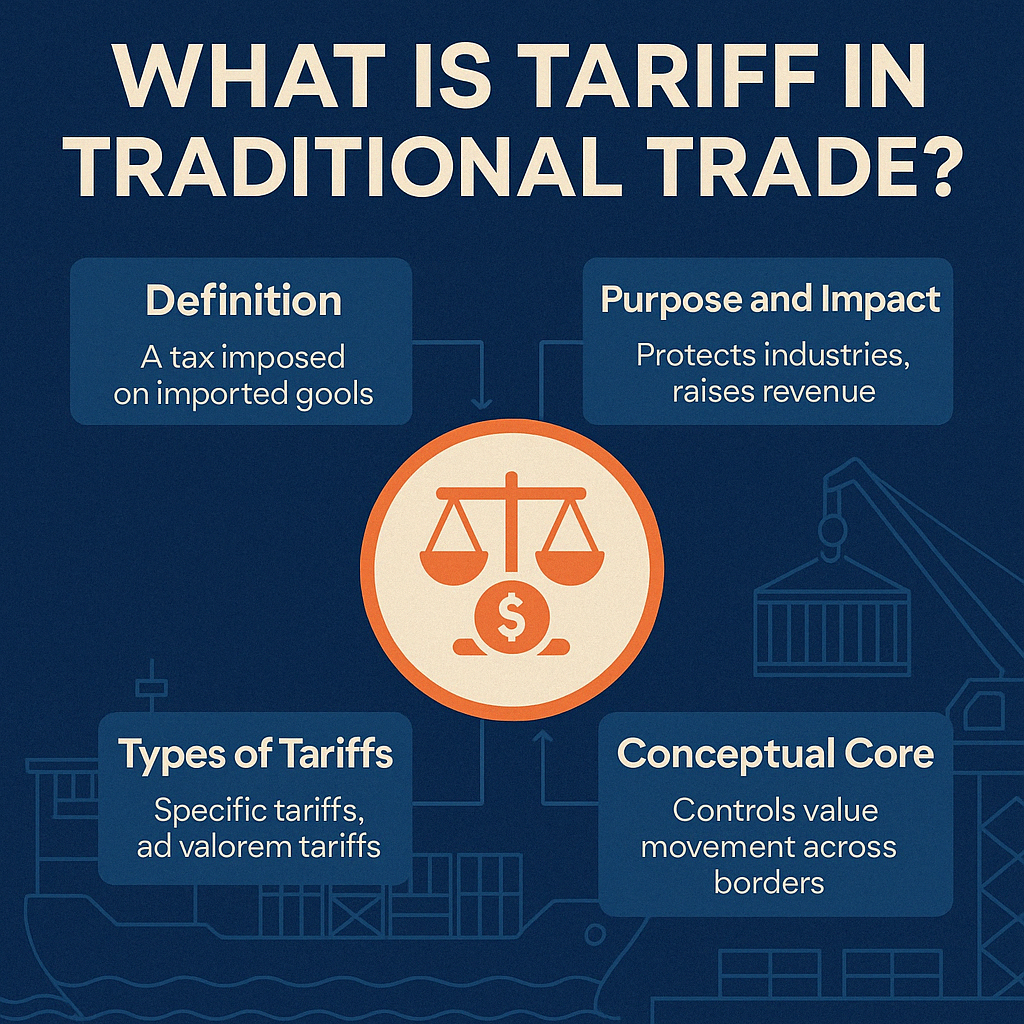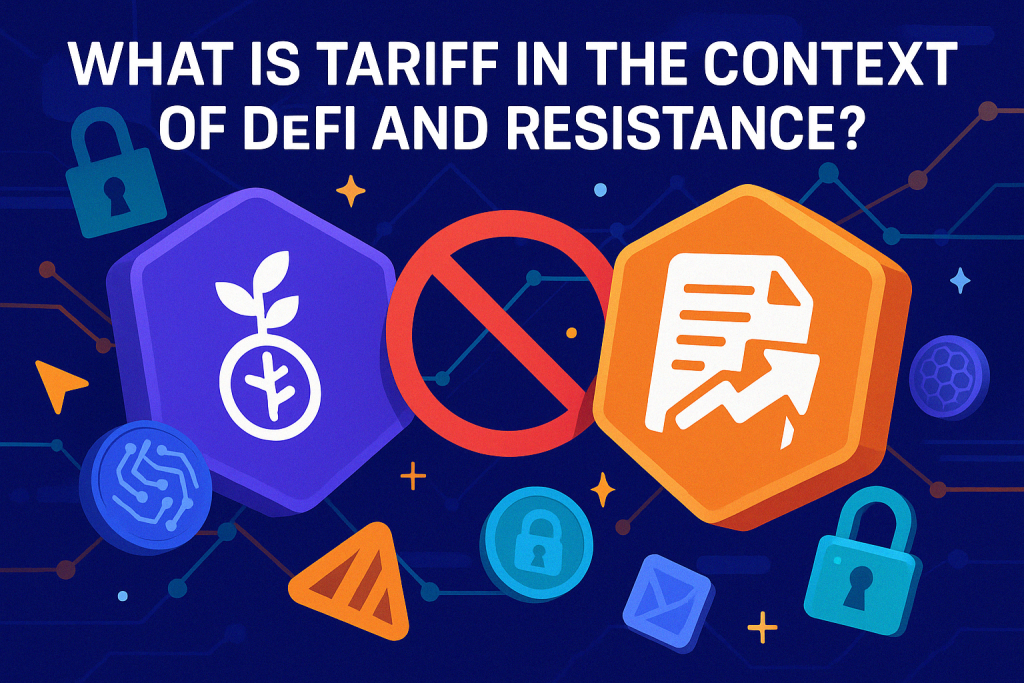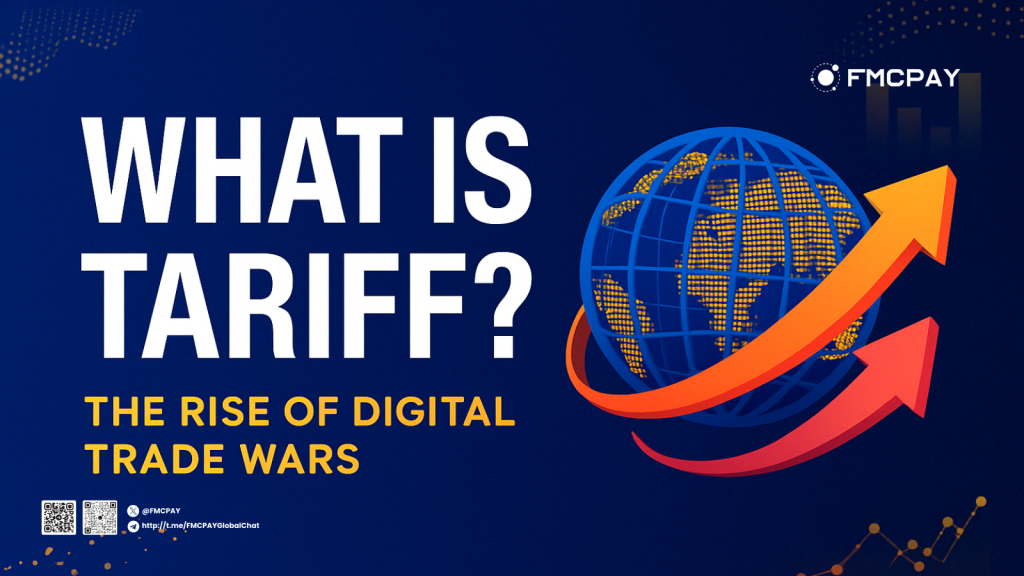To fully grasp how blockchain and crypto might reshape economic regulation, we need to start at the root: what is tariff in its most established and traditional form?

1.1.Definition
What is tariff in the conventional sense? A tariff is a government-imposed tax applied to goods and services as they cross international borders usually when entering a country. Tariffs are designed to influence trade behavior by making foreign goods more expensive or less attractive compared to local alternatives.
In traditional international trade, what is tariff has always been tied to tangible goods cars, clothing, electronics, agricultural products. However, as economic activity increasingly shifts into the digital space, governments are beginning to ask a new question: what is tariff when the traded product is a token, a stablecoin, or a digital NFT?
1.2. Purpose and Impact
Understanding what is tariff also means understanding why tariffs exist in the first place. Tariffs serve multiple national interests and are often used strategically for:
-
Protecting domestic industries: One of the most common answers to “what is tariff for” is protectionism. Tariffs make imported goods more expensive, which can encourage consumers to buy domestically-produced alternatives. This supports local businesses and helps preserve national employment.
-
Generating government revenue: Especially in developing countries, tariffs are an easy and reliable way to fund state operations. What is tariff in this case? A predictable stream of income that doesn’t rely on domestic income taxes or unstable markets.
-
Managing trade relationships: Countries use tariffs as tools for diplomacy or retaliation. For example, trade wars often begin when one country imposes tariffs on another’s goods. So what is tariff here? A political lever as much as an economic one.
1.3. Types of Tariffs
When considering what is tariff, it’s important to distinguish between the different forms it can take. The method of calculation matters in how tariffs are applied and understood.
-
Specific tariffs: These are fixed charges levied per physical unit, such as $100 per imported smartphone or $5 per kilogram of imported rice. In blockchain terms, a specific tariff might be akin to a flat transaction fee per cross-border crypto transfer.
-
Ad valorem tariffs: These are percentage-based fees charged according to the value of the item. For instance, a 15% tariff on a $1,000 television would result in a $150 tax. In crypto, this might resemble a smart contract charging 2% of the total token value during an international transaction.
So, when analyzing what is tariff, it’s not just the presence of a tax that matters but how it’s calculated and implemented. These categories could influence how governments translate tariff models into the blockchain space.
1.4. Conceptual Core
Zooming out, what is tariff really about? At its core, a tariff is about controlling value movement across jurisdictions. It’s a gatekeeping mechanism establishing the terms under which external goods or services can enter a market. It’s also about shaping consumer behavior, asserting economic sovereignty, and creating leverage in global negotiations.
Historically, what is tariff has been restricted to physical trade: ports, customs offices, and shipping lanes. But in today’s digital-first economy, where trillions of dollars in assets move in milliseconds across wallets and protocols, a new question is emerging: what is tariff when the “goods” are digital tokens, and the “border” is a blockchain?
That shift from tangible to digital, from ports to protocols sets the stage for the rise of crypto tariffs, programmable tax logic, and decentralized compliance systems that may redefine what tariff means in the next economic era.
2. What Is Tariff in a Borderless Blockchain Economy?
As blockchain becomes a foundational layer of the global digital economy, traditional concepts like tariffs are being reimagined. In a decentralized ecosystem where tokens can move frictionlessly and smart contracts function across borders without intermediaries, the question isn’t just what is tariff, but how can the logic of tariffs be applied in a world without ports or checkpoints?
The answer lies in how governments adapt old regulatory tools to new, borderless financial realities.

2.1. From Ports to Protocols: Tariffs Reimagined
Historically, tariffs were tangible—they involved physical inspections, paperwork, and checkpoints at national borders. Goods arriving by sea or air were taxed according to their volume, value, or origin.
But with crypto, digital assets can cross borders instantly, without permission or physical presence. There are no containers to open or customs officers to check payloads only code and keys.
In this new paradigm, tariff logic shifts from physical enforcement to digital infrastructure. Instead of taxing trucks and cargo, regulators now consider how to tax the movement of digital value, often through centralized points like exchanges or fiat gateways.
2.2. Governments Respond: Crypto as a New Trade Channel
As a result, many governments are beginning to treat crypto activity as a form of cross-border economic exchange, deserving of the same scrutiny as imports and exports. In this model, we’re already seeing early implementations of tariff-like mechanisms in areas such as:
-
Cross-border stablecoin transfers: Governments worry that stablecoins could replace fiat in international transactions, bypassing capital controls or tax reporting obligations.
-
Fiat-to-crypto on-ramps and off-ramps: These serve as entry/exit points to the digital economy, where authorities can enforce local tax laws, apply transaction fees, or require user identification.
-
Exchange withdrawals: In some jurisdictions, regulators have started tracking or taxing large withdrawals especially when assets are sent to wallets outside their legal oversight.
These measures aren’t called tariffs, but they serve a similar purpose: regulating external flow and capturing value that would otherwise leave their economic borders.
2.3. The New Shape of Tariffs: Smart, Silent, Seamless
Unlike traditional tariffs, which are visible and deliberate, digital tariffs may be invisible built into the very code of platforms and protocols. Examples include:
-
Gas taxes: Some protocols could impose additional fees based on user geography or jurisdiction, akin to regional tariffs.
-
Smart contract hooks: Governments might require that tax collection or KYC verification be coded directly into contracts that enable asset bridging or lending.
-
Exchange compliance rules: Centralized platforms could be compelled to collect “exit duties” on large crypto transfers, mimicking customs duties on outgoing goods.
These approaches represent a new category of policy: automated, programmable regulation, tailored to a decentralized world but rooted in long-standing trade principles.
2.4. Control vs. Innovation: A Balancing Act
While these digital adaptations may make sense from a regulatory standpoint, they also raise complex questions:
-
Will decentralized protocols be forced to fragment liquidity along national lines?
-
Could Layer 2 networks or cross-chain bridges become new battlegrounds for enforcement?
-
How will user privacy be preserved when digital tariffs require location-based data?
The reality is that digital tariffs may benefit from blockchain transparency, but they also challenge its ideals of openness and censorship resistance. The future will likely require a careful balance between regulatory compliance and protocol autonomy.
The evolution of tariffs from paper-bound customs duties to code-based transaction rules marks a major turning point in global economics. While traditional trade policy was limited by logistics, crypto policy can be enforced at the speed of code.
Tariffs in this new form are no longer physical they’re programmable, dynamic, and deeply intertwined with the architecture of Web3.
3. What Is Tariff’s Role in the Coming Digital Trade Wars?
As cryptocurrencies reshape global finance, governments are beginning to enforce sovereignty not only on borders and goods but also on data, capital, and code. In this geopolitical evolution, what is tariff becomes a central question in understanding how states will govern decentralized economies.
We are witnessing the rise of digital trade wars, where the battleground is not steel, oil, or corn but tokens, smart contracts, and protocols. Just like in traditional trade conflicts, the tools being used regulation, access control, and taxation mirror the purpose of tariffs in shaping global power dynamics.

3.1. Regulatory Restrictions: Digital Firewalls in Action
A growing number of countries are imposing regulatory firewalls around their digital economies. These restrictions target crypto platforms based overseas, especially those offering high-yield DeFi products, privacy tools, or unregulated stablecoins.
For example:
-
The U.S. SEC and CFTC have filed lawsuits against major global exchanges like Binance and Coinbase for allegedly violating domestic securities laws.
-
India has banned crypto trading platforms from operating unless registered with local authorities and has imposed a 1% TDS tax on every crypto transaction.
-
Nigeria and China have implemented full or partial bans on crypto activity, favoring government-controlled systems like CBDCs.
In these cases, what is tariff transforms into a control mechanism over digital access a way to block or penalize economic flows that are deemed non-compliant or threatening to national stability.
3.2. Licensing & Compliance Walls: Tariffs as Access Control
Rather than full bans, some governments are building licensing walls that resemble tariffs in function. These compliance frameworks allow international crypto platforms to operate, but only after meeting strict legal, financial, and technological standards.
Take the European Union’s MiCA regulation (Markets in Crypto-Assets), which will soon require all crypto firms to:
-
Register with a local EU authority
-
Disclose detailed tokenomics and risk assessments
-
Implement robust AML/KYC frameworks
This raises a broader interpretation of what is tariff: it’s no longer just a fee it’s a gatekeeping system, deciding who may legally operate in a market, and under what terms. This mimics how import licenses or regulatory quotas function in traditional trade.
3.3. Taxation of Repatriated Crypto Assets: Digital Wealth Duties
Governments are also focusing on repatriation taxation imposing duties on crypto holdings that return to their legal or geographic jurisdiction.
Examples include:
-
South Korea, which is planning to enforce a 20% capital gains tax on crypto profits exceeding 2.5 million.
-
France, which treats crypto-to-fiat conversions as taxable events.
-
Indonesia, which now applies VAT (value-added tax) on crypto trades, viewing them as digital goods.
These policies demonstrate that what is tariff in a crypto context may be disguised as capital controls or income tax mechanisms, designed to capture value that would otherwise exit or bypass the regulated economy.
3.4. Fragmentation of the Global Blockchain Ecosystem
The long-term consequence of these digital tariffs may be a fragmented global blockchain infrastructure, much like the fragmented trade environment of the 20th century.
We could see:
-
“Regulated DeFi” ecosystems operating under national law, separated from global permissionless finance
-
Exchange listings that vary by region based on legal interpretations of tokens (security vs. utility)
-
Isolated liquidity and pricing disparities between users in compliant vs. non-compliant countries
This creates a world where tariffs and barriers exist within the internet itself, leading to regional silos of blockchain activity instead of one unified financial layer.
So again, what is tariff in this scenario? It’s a tool of digital sovereignty a way for states to draw lines in the sand on a borderless map.
As the crypto space matures, tariffs may no longer look like taxes on imports, but rather:
-
Limitations on code deployment
-
Restrictions on user onboarding
-
Protocol-level taxation systems based on geography
Ultimately, what is tariff in this new context is both an economic strategy and a regulatory ideology. It marks the intersection of national power and decentralized innovation a conflict that will define how Web3 develops in the years to come.
4. Smart Contracts and the Future: What Is Tariff as Code?
As blockchain ecosystems mature and regulation evolves, one question rises to the forefront of crypto policy and innovation: what is tariff in a world where enforcement is not manual, but programmable?
In this future, tariff logic may no longer be written in law books, but in lines of smart contract code executed automatically and without human discretion.
4.1. From Paper to Protocol: Tariffs Become Code
Historically, tariffs required infrastructure—customs officers, port authorities, forms, inspections. But now, smart contracts offer an opportunity to make tariff enforcement instant, automated, and transparent. That raises a compelling evolution of the concept: what is tariff when it’s built directly into the blockchain layer?
Here, tariffs can be enforced as self-executing rules based on user location, token origin, or regulatory compliance.
4.2. How Programmable Tariffs Might Work
In a programmable crypto economy, tariff mechanisms could be embedded into DeFi protocols, NFT platforms, bridges, and even wallets. Examples include:
-
Cross-chain tariffs: A smart contract detects that an asset is being bridged from a restricted or high-tax jurisdiction and automatically applies a jurisdiction-based fee before confirming the transaction.
-
DeFi withholding: Lending or staking protocols could implement location-aware taxation automatically deducting a percentage of rewards for users in specific countries and sending it to a regulatory smart contract wallet.
-
Geo-fenced access: Certain smart contracts may block or charge extra for users from blacklisted regions, acting as digital equivalents to trade sanctions or restricted import zones.
So in this scenario, what is tariff? It’s no longer just a government directive it’s programmable compliance woven into the logic of decentralized apps.
4.3. Benefits and Trade-offs of Tariff-as-Code
There are powerful advantages to embedding tariffs in smart contracts:
-
Transparency: Fees, rates, and rules are visible on-chain and can’t be altered arbitrarily.
-
Efficiency: No need for manual audits, paperwork, or post-facto enforcement.
-
Automation: Tariff logic executes at transaction speed, reducing administrative overhead.
But this future also brings risks:
-
Privacy erosion: Enforcing region-specific tariffs may require user tracking, undermining Web3’s privacy principles.
-
Censorship risks: Over-regulation through code could limit access to decentralized services.
-
Fragmentation: Protocols may fork or split between compliant and non-compliant versions, deepening the divide in global crypto access.
These challenges force us to rethink not just what is tariff, but who should define it and how it should be applied in a decentralized future.
4.4. Toward a Programmable Compliance Layer
As regulators and developers search for middle ground, we may see the rise of compliance middleware smart contract layers designed specifically to handle programmable tariffs, reporting, and geo-boundary enforcement. This could become a core layer of institutional DeFi, where tariff enforcement is non-negotiable for legal use.
The ultimate goal? Building a financial system that respects jurisdictional laws without sacrificing the borderless promise of Web3
5. What Is Tariff in the Context of DeFi and Resistance?
As regulators worldwide explore how to impose control over the flow of digital assets, the decentralized finance (DeFi) community finds itself at a crossroads. Within this environment of open-source protocols, anonymous users, and borderless liquidity, what is tariff perceived as?
To many DeFi advocates, it represents not just a regulatory tool but a fundamental threat to the ethos of decentralization.
5.1. Tariffs vs. Permissionless Finance
In the world of decentralized finance, what is tariff often viewed as? A limitation on freedom. Tariff-like enforcement whether in the form of geo-restrictions, transaction fees, or compliance-based access controls introduces friction into a system designed for permissionless innovation.
Unlike centralized exchanges or fintech platforms that can adjust to jurisdictional demands, DeFi operates as a protocol layer global by design and resistant to borders. For developers, the question isn’t just what is tariff, but how can decentralized systems defend against it without compromising their architecture?
5.2. The Community’s Response: Innovation Through Resistance
DeFi builders are already experimenting with mechanisms to preserve open access, even in the face of increasing regulation. These strategies include:
-
Routing around centralized checkpoints: Projects are shifting liquidity away from regulated exchanges and fiat gateways, using decentralized bridges and wrapped assets to keep value flowing outside of traditional oversight.
-
Fragmenting liquidity by jurisdiction: In anticipation of regulatory fragmentation, some protocols are preparing to spin up regional liquidity pools or fork protocols to create compliant and non-compliant versions.
-
Creating “tariff-free zones” on-chain: New platforms are emerging with privacy-preserving features, such as zero-knowledge proofs, anonymous wallets, or decentralized identity systems that reduce the ability of external actors to enforce tariffs or geo-based restrictions.
These responses illustrate the DeFi ethos: if tariffs are imposed on centralized points, users and developers will simply build around them.
5.3. The Inescapable Points of Control
However, even in this decentralized pushback, what is tariff still finds a foothold especially through the centralized touchpoints that link crypto to the traditional financial system.
Regulators can still:
-
Target fiat on- and off-ramps, where users convert crypto to real-world currency
-
Enforce tariffs through stablecoin issuers, requiring them to comply with transaction tracking and jurisdictional tax collection
-
Apply pressure on bridges and aggregators, which act as infrastructure hubs for liquidity movement
These points act as regulatory chokeholds, where even DeFi protocols may have to embed tariff logic in order to remain accessible in certain regions.
5.4. DeFi’s Dilemma: Compliance or Exit?
As regulatory pressure intensifies, DeFi faces a growing dilemma: comply with evolving frameworks or risk losing access to broader user bases and institutional liquidity. While some projects are choosing to integrate with compliance layers (such as KYC-enabled wallets or audit trails), others are doubling down on censorship resistance and anonymity.
So the question isn’t just what is tariff it’s how far will DeFi go to avoid it?
-
Will DeFi protocols split into “regulated” and “uncensored” ecosystems?
-
Could jurisdictional compliance create two parallel versions of Web3 one for institutions, and one for cypherpunks?
-
And if tariffs are embedded in the infrastructure, will true decentralization still be possible?
In the context of DeFi, what is tariff becomes a proxy for a much larger conversation: who controls the future of finance? Tariffs, in their digital form, represent an attempt to bring borderless systems back within national boundaries. But as history shows, technology often adapts faster than regulation.
DeFi’s ability to preserve openness while navigating legal realities will determine whether it remains a radical experiment or becomes the foundation of tomorrow’s global economy.
Conclusion
In today’s blockchain-powered economy, what is tariff is no longer just a textbook definition it’s a live question shaping the future of global finance. As crypto continues to blur the lines between jurisdictions, technologies, and traditional financial systems, the role of tariffs is being reimagined for a decentralized world.
From Layer 1 chains and smart contracts to CBDCs and permissionless DeFi platforms, a deep understanding of what is tariff its origins, its digital transformation, and its policy implications will be essential for building systems that are not only scalable and innovative, but also compliant and resilient across borders.
As regulation catches up with innovation, staying informed becomes critical. For more insights like “what is tariff” and how governments, protocols, and developers are shaping the next phase of crypto infrastructure, follow FMCPAY News for expert analysis on blockchain regulation, digital trade dynamics, and the evolving rules of the decentralized economy.


